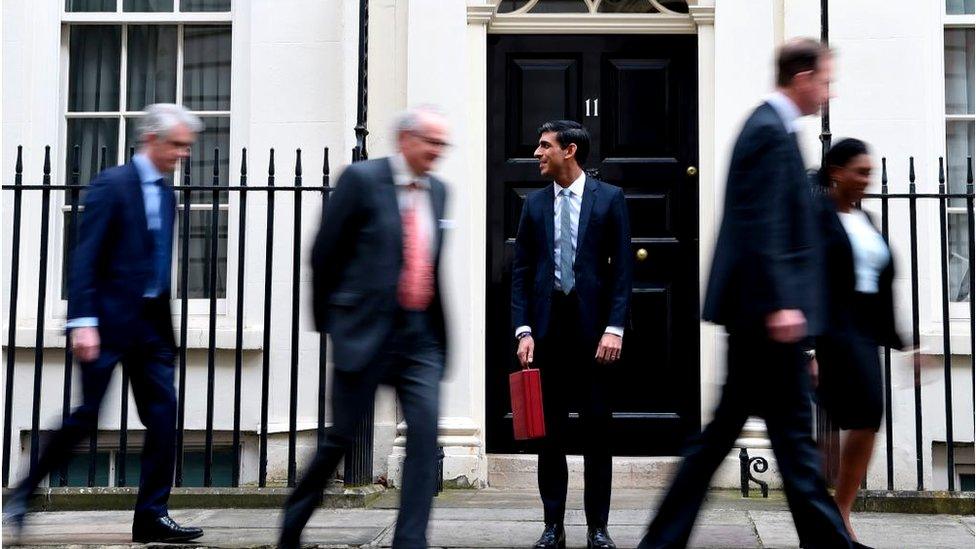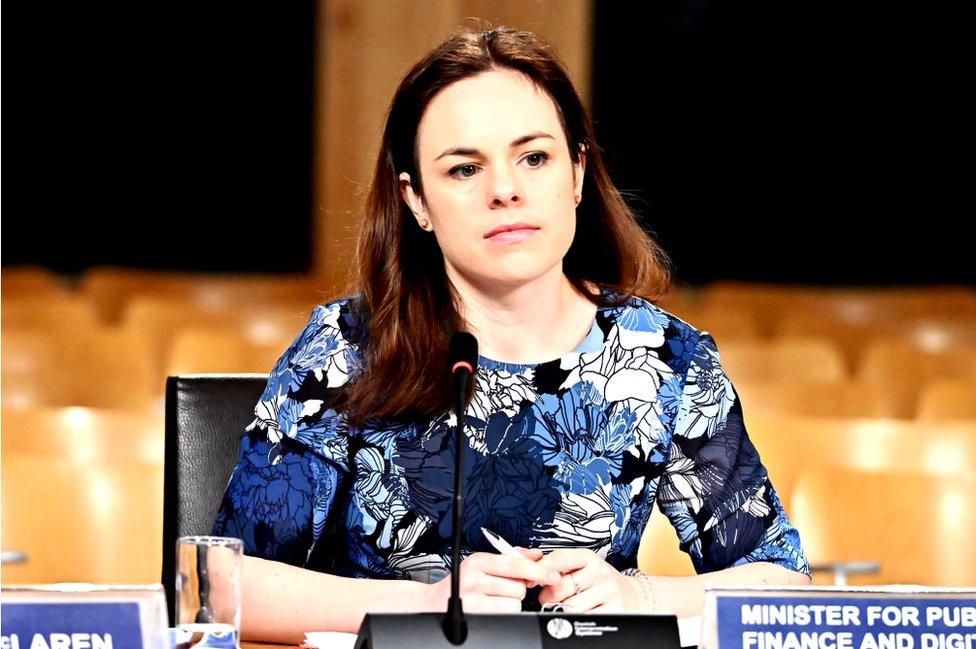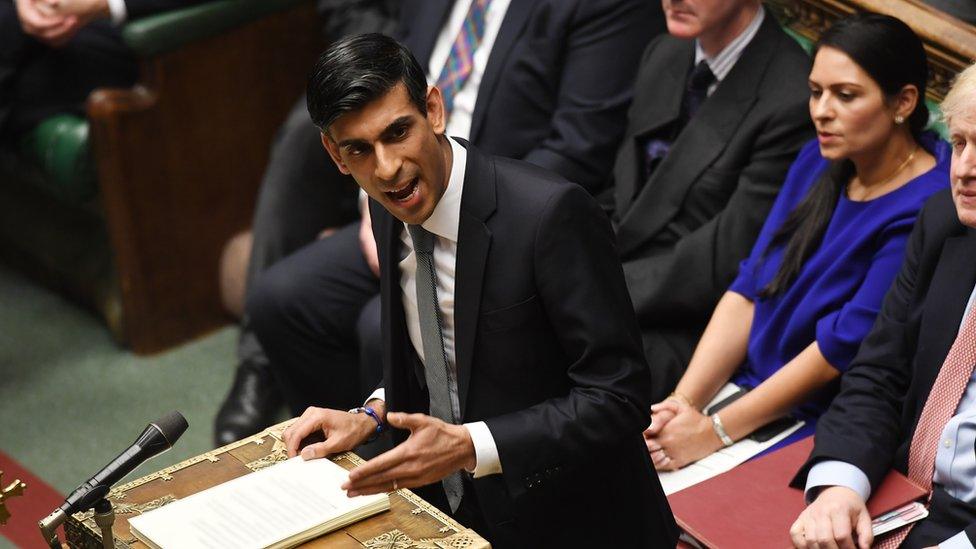Scotland must act fast to answer virus Budget
- Published

There are two tranches of money going to Holyrood from the Treasury, including £360m or so to tackle the health crisis.
Rishi Sunak's Budget will have raised expectations that Kate Forbes will follow his lead in Scotland, on support for business and a hardship fund through councils.
There are now so many holes in the business rates system that it looks ripe for major surgery, or replacement.
Holyrood is to get a down-payment of about £360m to help Scotland through the coronavirus pandemic.
That's the ballpark figure for the share of funding that will head to Holyrood in lieu of measures being introduced in England, much of that for business.
It is part of £700m expected to flow to Scotland, Wales and Northern Ireland from the decisions announced in Wednesday's Budget at Westminster to help the economy through the crisis.
That includes a share of the £500m hardship fund, which the Chancellor, Rishi Sunak, has announced will be distributed through English local councils.
The consequent £50m or so does not have to be spent in the same way by Scottish ministers, but they will be under some pressure to follow at least that Westminster example.

Money has been made available to get the UK through the coronavirus crisis
Some money also heads to Holyrood because small English firms are to get business support grants of £3,000.
But the biggest tranche is in lieu of the one-year business rates holiday being given to smallish businesses in hospitality, retail and leisure.
That's money that will no longer be raised by English councils. The Treasury compensates local authorities for that loss of income, so the Treasury reckons a share of that compensation should go to the devolved administrations at Holyrood, Cardiff Bay and Stormont.
Cash lubricant
Will the Scottish government do the same with business rates? The fact that English businesses in those sectors have gained such a big tax break will have raised expectations that the same should be done for Scots firms.
But it's up to Kate Forbes, the new finance secretary, to propose how to use this windfall money for emergency, one-off measures.
She will have to move fast. The first "community transmission" of coronavirus in Scotland has been confirmed. That starts the clock ticking on a pattern of epidemic which is thought most likely to peak two to three months later.
Facing the prospect of up to a fifth of the workforce too ill to work at any one time, and the risk of cash flow drying up throughout the economy, the measures being taken by Rishi Sunak are intended to keep the cash lubricant in the economic engine.
He did not, as requested, give others a break from the regular drumbeat of having to pay VAT bills. And larger firms, across several sectors, have suggested that the measures aimed at the huge number of small firms seem to forget that a small number of large firms are very big employers.
Some may have easier access to capital and credit, but it's not going to be a breeze for them either.
They can now make their case to get a chunk of the £5bn contingency fund. That is available to the NHS as necessary. Mr Sunak has said the government will dig deep and do whatever it takes to get through the health emergency.
Tell-tale sign
How else does the rest of the Budget - the non-virus bit - feed money into Scottish spending? Whitehall will want to take some credit for the roll-out of 4G mobile masts to those hard-for-the-market-to-reach bits of Britain.
It is also pumping more money into city and region growth deals, with a new £25m for Argyll and Bute. In England, these growth deals are designed to leverage in the devolution of power, including a new mayoral office for West Yorkshire.

Finance secretary Kate Forbes will have to make rapid decisions on spending
In Scotland, they have the reverse intention: to challenge the dominance of the devolved authority in economic development. The Scottish government has readily signed up to matching the funds, yet that shared endeavour means that it's a method for the Treasury and the Scotland Office to plant a British flag on Scottish turf, to say: "We're doing this, not everything on this patch is Holyrood's".
However, the main uplift in spending is through Holyrood - a £640m addition to the block grant, through the Barnett Formula. For this, you have to put aside the calculations for the pandemic crisis. Instead, take the £2.3bn additional funding for the NHS in England, and add a formulaic share to Holyrood.
Then take a much smaller element of business rates relief aimed at cinemas in England, and likewise, there's a shareout for the devolved administrations.
Impressed and bamboozled
That £640m is a tell-tale sign of the bigger picture in this budget. When all the rhetoric is stripped away, it's a measure of how much is changing next financial year.
Two-thirds of it is for capital spending, and one third for revenue, or day-to-day spend.
If you listened to Mr Sunak, you might well be impressed and probably bamboozled by the colossal sums of money being splurged around the House of Commons. You would be convinced that austerity has ended.
There were moments when he could have been a Labour Chancellor, rather than heir to the Osborne-Hammond years of screwing down deficits as a matter of fiscally Conservative orthodoxy.
But Conservatives have discovered, after 10 years in government, that deploying borrowing powers at low interest rates to boost the productive capacity of the economy has set it on a course to grow faster. Who'd have thought it!? Imagine if they'd thought that 10 years ago.
This Budget's bigger figures, however, were to be spread over three to five years, and capital spending dominates. There's a huge wadge of capital budget pencilled in for 2021.
But for next year, it's more modest. If Scotland is getting £210m additional funding for day-to-day spending, and much of that is linked to a boost for health, it suggests a UK lift of associated departmental spending of around £2bn.
That's helpful for public services, but it doesn't leave much for non-health. And even if you claim that it ends austerity, it barely begins to reverse the squeeze.
Rate cut
There will be plenty more to say about this unique budget as events unfold. The health crisis has left the Office for Budget Responsibility, and therefore the rest of us, very unclear what economic growth rate and revenue can be expected.
As if coronavirus weren't bad enough, Brexit continues to cast a shadow over this year and well into next. Will the talks on the future relationship with the EU take place over the next few months, as countries cut back on travel and meetings?

Business rates are due for reform
An indication of the problems it has left the economy is new data showing output in January did not rise at all. That was the month some surveys were pointing to a post-election boost in business confidence - or if not full-on confidence, at least improved Brexit clarity.
But one other observation I'll offer for now. Business rates look like their days are numbered. Few will mourn their passing, as a tax on buildings and land, at a time when the economy has an increasing orientation away from bricks and mortar and towards the digital.
The business rates holiday in England, perhaps to be extended into Scotland, means nearly half of business premises are going untaxed during next financial year.
In Scotland, for more than a decade, billions have been committed to a business rates relief scheme for small businesses. Only now is it being assessed for its effectiveness as a direct contributor to business growth and employment.
The Scottish government commissioned a review of business rates, but constrained the reviewers by requiring any changes to end up with the same amount of revenue - currently around £2.8bn per year. The upshot was underwhelming, and failed to address the unfair low tax burden on digital firms which keeps conventional shopkeepers squealing in highly-taxed pain.
Modest changes have been enacted, but despite 20 years of being fully devolved, Scottish business rates have tracked English ones closely.
Back at the Treasury, with half of businesses out the reach of business rates for a year, a deeper review has been launched.
An alternative system is not obvious, and reform would doubtless be politically troublesome. But if business rates are reformed out of recognition in England, Scotland would be under pressure from business lobbies to revisit the issue.
- Published11 March 2020

- Published11 March 2020
- Published5 March 2020
